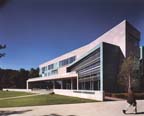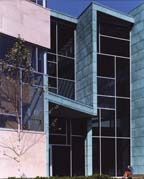
A 65,000-square-foot campus center -- home to student organizations as well as a bookstore, library, cafe, recital hall and 249-seat theater -- has recently been added to Brandeis University in Waltham, MA, due to a generous gift from Carl and Ruth Shapiro. Designed by Charles Rose Architects of Somerville, MA, the Carl and Ruth Shapiro Campus Center features Cenia limestone, which matches the existing materials that can be found on prominent buildings around the campus. As a result of its outstanding stonework, the project received a 2004 Tucker Award from the Building Stone Institute in the “Non-Residential Winner†category.
According to Principal Architect Charles Rose, the goal of the project was to create a signature building on campus that would also blend in seamlessly. “The use of limestone was an attempt to make these forms feel at home on the campus,†said the architect. “We wanted to have a material continuity with some existing buildings, but also to provide a far more contemporary look. We wanted venerability, but at the same time wanted to use material with more interest and more color. There is really some wonderful variation in the stone we chose. I think there are some fossilized elements to the stone, and warmth to the color that make the limestone very appealing.â€
The stone was used primarily on south elevation, since the architects wanted that portion of the building -- which faces onto a public landscape -- to have a distinguishing facade.
Kenneth Castellucci & Associates, Inc. of Lincoln, RI, served as both the supplier and installer of the stone for the project. According to Mike Varone of Kenneth Castellucci & Associates, Inc., the company supplied 10,000 square feet of Cenia limestone with a flamed finish. He said that the stone was applied in a random repeating pattern with pieces ranging in size. Varone also said that the project called for a conventional handset installation method. The stone was mechanically fastened using stainless steel anchors, and stone-to-stone joints were filled with sealant. Overall, it took approximately three months to install the material, with a range from two to eight workers on the job at any given time.
Varone explained that Cenia limestone comes from nine different benches from a quarry in Spain. “This project called for four of the nine benches,†he said. “We had to come up with a system to ensure that the four different benches were blended together -- not uniform, but we didn't want a checkerboard pattern either. We wanted a homogenous effect of all four different types of the benches.â€
The supplier explained that this aspect of the project was initially dealt with during the shop drawing process. “The project was fabricated in Italy, and we had to make sure that each random pattern was blended to our specifications,†said Varone. “Each piece was crated per [its] pattern, and then shipped to us, which really helped facilitate the installation.â€
Rose and Varone both said that the stone was carefully detailed to maximize the project's limited budget. All of the corners and exposed edges of the building are clad in 3-inch-thick pieces of limestone, while the main veneer had to be reduced to 1 1â„4-inch-thick pieces. “We came up with some nice details that make the stone look thick, but it's actually really thin,†said Rose.
In addition to the limestone, granite paving stones were used for terraces, while a black prairie stone was used for the first course of all the stonework on the building.
“The reaction has been extremely positive, especially the stonework,†said Rose. “I get the feeling that the client would have liked for us to even use more stone.â€

End box
The Carl and Ruth Shapiro Campus CenterBrandeis University
Waltham, MA
Architect: Charles Rose Architects, Somerville, MA
Stone Supplier/Installer: Kenneth Castellucci & Associates, Lincoln, RI
